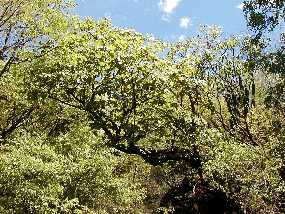Research and Conservation in Southern Sonora, Mexico
Pseudobombax palmeri (cuajilote)
A small tree found at the upper limit of tropical deciduous forest and into the lower oak zone. The trunk and main branches
are semisucclent and thus thicker than those of "normal" trees. The flowers appear in March.
The genus Pseudobombax is distinguished from Bombax by the relatively small petals and the numerous, large stamens that
form the conspicuous part of the flower (the "shaving brush" form). Bombax flowers have large petals and relatively few and
smaller stamens.
 |
 |
| The plated bark of Pseudobombax palmeri is distinctive, though it might be confused with that of Lysiloma divaricata which is a more erect, nonsucculent tree. Photos: Mark Dimmitt | |
 Flower of Pseudobombax palmeri. Photo: Mark Dimmitt |
 Leaf of Pseudobombax palmeri. Photo: Mark Dimmitt |
 Pseudobombax palmeri growing on a rocky arroyo bank east of Alamos, Sonora. Photo: Mark Dimmitt |
 Pseudobombax palmeri green fruits. Photo: S.A. Meyer |

